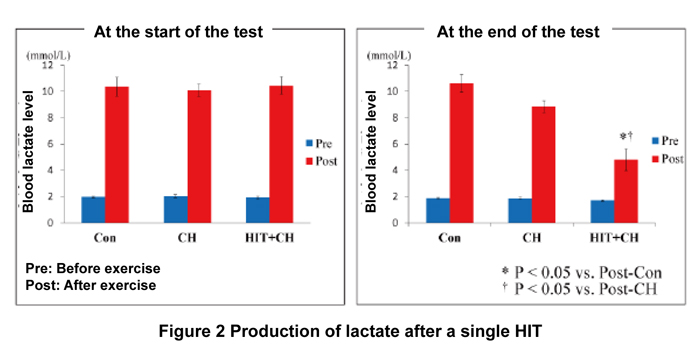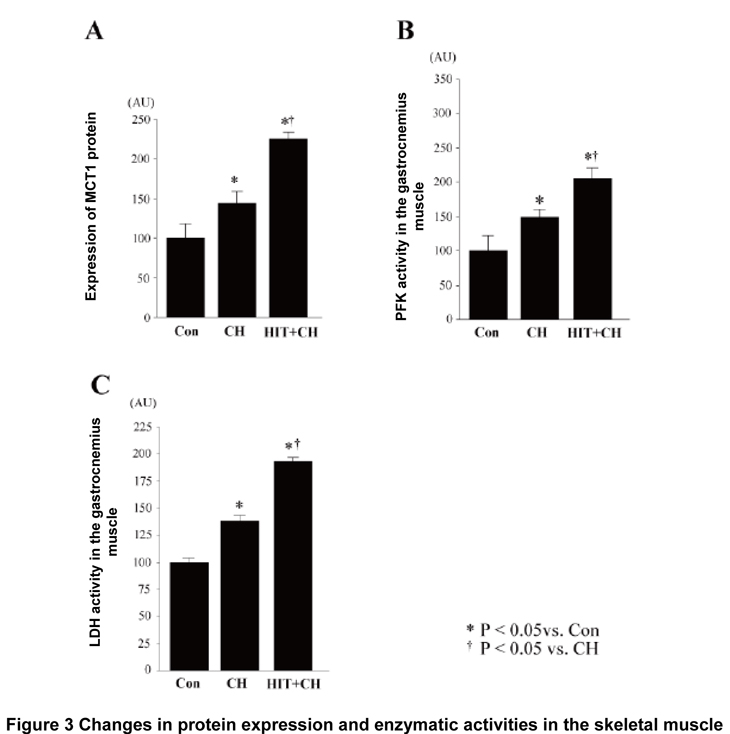- TOP
- List of reports
- Chronic Chlorella intake and short-term, high-intensity, interval training enhances exercise
capacity and glycolytic enzyme metabolism in muscles.
Chronic Chlorella intake and short-term, high-intensity, interval training enhances exercise capacity and glycolytic enzyme metabolism in muscles.
【Scientific information】
Research and Development Department, Sun Chlorella Corporation
Chronic Chlorella intake and short-term, high-intensity, interval training enhances exercise capacity and glycolytic enzyme metabolism in muscles.
Presented at the 70th Annual Meeting of Japan Society of Nutrition and Food Science
- Study objective
- It has already been reported that the intake of Chlorella prolongs the duration of exercise in mice; however, the effect of long-term intake of Chlorella on anaerobic exercise capacity and the combined effect of exercise and Chlorella on energy metabolism in the skeletal muscle have not been clarified. Therefore, a study was conducted to investigate the effect of the combination of long-term intake of Chlorella and short-term, high-intensity, interval training*1 (HIT, Tabata training) on exercise capacity and anaerobic energy metabolism in the skeletal muscle.
- Study method
- The study was conducted using 12-week-old rats, which were assigned to a total of 3 groups (10
rats/group): 1. Control group (Con), 2. Chlorella ingestion group (CH), 3. Short-term, high-intensity,
interval training + Chlorella ingestion group (HIT + CH).
The rats in HIT + CH groups were made to exercise with a weight (16% of the body weight). An exercise set consisting of 20 seconds of swimming followed by 10 seconds of rest was repeated 14 times a day, 4 days a week for 6 weeks. After 6 weeks of training, the maximum number of cycles that was continuously performed by rats (number of repeated cycles of 20 seconds of swimming and 10 seconds of rest) and blood lactate levels before and after a single HIT were determined as the indicators of exercise capacity.
In addition, gastrocnemius muscles were removed 48 hours after the end of the last exercise, and the levels of monocarboxylic acid transporter-1 (MCT1)*2 , phosphofructokinase (PFK)*3, and lactate dehydrogenase (LDL)*4 were measured.
- Results
- The maximum number of HIT cycles that were continuously performed by rats was increased in
the Chlorella group (CH) compared to the control group (Con). Furthermore, it was significantly
increased in the group that received the combination of HIT and Chlorella (HIT + CH) compared to
the CH and Con groups (Figure 1).
The blood lactate level after a single HIT showed tendency to reduce in the CH group compared to the Con group, which was significantly reduced in the HIT + CH group (Figure 2).
The expression of MCT1 protein (Figure 3A) and enzymatic activities of PFK (Figure 3B) and LDH (Figure 3C) in the gastrocnemius muscle were significantly increased in the CH group compared to the Con group, which were further significantly increased in the HIT + CH group. - Based on the results above, a possibility was indicated that the long-term intake of Chlorella may improve exercise capacity and anaerobic energy metabolism in the skeletal muscle. In addition, a possibility was also indicated that the combined use of HIT and Chlorella intake may further improve these effects.



Terminology
- *1:Short-term, high-intensity, interval training (HIT, Tabata training)
- A training method in which 20 seconds of high-intensity exercise and 10 seconds of rest are repeatedly performed is known as Tabata training. Although it is an intensive training program that leads to complete exhaustion, it has attracted attention in the Western countries as the method to achieve the desired effect in a short time.
- *2:Monocarboxylic acid transporter-1 (MCT1)
- A transporter of lactate. It is abundantly present primarily in the heart and slow muscles, and promotes the transport of lactate from outside to inside of the cell.
- *3:Phosphofructokinase (PFK)
- A primary enzyme in the glycolytic pathway that synthesizes acetyl CoA. Glycolytic energy production pathway anaerobically synthesizes energy substance (ATP). In this study, PFK was measured as an indicator of anaerobic energy production capacity.
- *4:Lactate dehydrogenase (LDH)
- A type of enzymes that functions in the final step of anaerobic glycolytic pathway that synthesizes energy substance (ATP) through metabolism of sugar and production of lactate in the body. In addition, LDH is an enzyme that synthesizes pyruvate from lactate. Although LDH is present in a number of cells, it is particularly abundant in the liver, kidney, cardiac muscle, skeletal muscle, and erythrocyte.
Details
- Meeting:
- The 70th Annual Meeting of Japan Society of Nutrition and Food Science
- Title:
- Long-term intake of Chlorella enhances anaerobic exercise capacity and glycolytic metabolism in the skeletal muscle
- Authors:
- Naoki Horii1), Natsuki Hasegawa1), Shunpei Fujie1), Toru Mizoguchi2), Masato Ohnishi2) , Koji Sato3), Izumi Tabata1), Motoyuki Iemitsu1)
- Affiliation:
- 1) Faculty of Sport and Health Science, Ritsumeikan University
2) Sun Chlorella Corporation
3) Graduate School of Human Development and Environment, Kobe University





